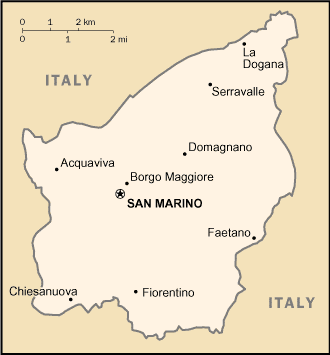|
San Marino
|

|
Capital: San Marino
Population: 33,860
Brief History of San Marino:
San Marino is a small country located within and surrounded completely by Italy. The country was founded in 301 AD by Marinus the Dalmatian. He was a Christian stonemason who was fleeing the persecution of Christians by Roman Emperor Diocletian. Marinus hit on the top of Maount Titano in San Marino and founded a small community there. The country was named San Marino after Marinus.
Originally San Marino was just Mount Titano, however in 1463 as the result of an alliance against the Lord of Rimini, the Pope awarded the country the cities of Montegiardino, Serravalle, and Fiorentino. Another town, Faetano, joined later that same year.
The Geography of San Marino
Total Size: 61 square km
Size Comparison: about 0.3 times the size of Washington, DC
Geographical Coordinates: 43 46 N, 12 25 E
World Region or Continent: Europe
General Terrain: rugged mountains
Geographical Low Point: Torrente Ausa 55 m
Geographical High Point: Monte Titano 755 m
Climate: Mediterranean; mild to cool winters; warm, sunny summers
Major cities:
The People of San Marino
Type of Government: independent republic
Languages Spoken: Italian
Independence: 3 September A.D. 301
National Holiday: Founding of the Republic, 3 September (A.D. 301)
Nationality: Sammarinese (singular and plural)
Religions: Roman Catholic
National Symbol: three peaks each displaying a tower
National Anthem or Song: Inno Nazionale della Repubblica (National Anthem of the Republic)
Economy of San Marino
Major Industries: tourism, banking, textiles, electronics, ceramics, cement, wine
Agricultural Products: wheat, grapes, corn, olives; cattle, pigs, horses, beef, cheese, hides
Natural Resources: building stone
Major Exports: building stone, lime, wood, chestnuts, wheat, wine, baked goods, hides, ceramics
Major Imports: wide variety of consumer manufactures, food
Currency: euro (EUR)
National GDP: $1,371,000,000
** Source for population (2012 est.) and GDP (2011 est.) is CIA World Factbook.
Back to Geography Home Page
